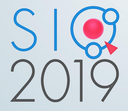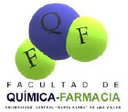Executive Secretary

7th International Chemistry Symposium
SIQ 2019
Cholesterol is an essential lipid which is found in cell membranes of animals, however its high accumulation in blood results in fatal diseases. On the other hand, hexacyanoferrates(III) of transition metals represent an interesting family with ability electrocatalyze the decomposition of hydrogen peroxide. In the present work, enzyme biosensors for cholesterol were prepared using a transduction platform constituted by a glassy carbon electrode modified with a novel Prussian-blue analogue containing Co2+ and Mn2+ in the outer coordination sphere. The electrochemical characterization of this material indicated the presence of two redox waves displaying quasireversible kinetics, whose equilibrium formal potentials were 0.46 V and 0.83 V respectively. The electrocatalytic activity of the system hexacyanoferrate/NAFION® with H2O2 was evaluated. Thus, we observed the appearance of increased anodic signals due to the H2O2 oxidation. The immobilization of cholesterol oxidase was performed by entrapment in a SOL-GEL matrix composed by tetraethoxysilane, a solution of cetyltrimethylammonium bromide (3.8%, w/v) and a phosphate buffer solution (pH = 7). Electrochemical determinations were conducted by cyclic voltamperommetry. The modified electrode presented a fast and reproducible response towards successive additions of cholesterol, thus confirming that the enzyme preserved the enzymatic activity after immobilization The biosensor presented a limit of detection of 30 µM and two linear ranges with a sensitivity of 385 μA cm-2/mM between 50 µM – 150 µM, and a smaller sensitivity of 80 μA cm-2/mM between 150 µM – 1 mM. In addition, the biosensor displayed specificity and selectivity towards cholesterol in presence the steroids and others electroactive species.
Cholesterol is an essential lipid which is found in cell membranes of animals, however its high accumulation in blood results in fatal diseases. On the other hand, hexacyanoferrates(III) of transition metals represent an interesting family with ability electrocatalyze the decomposition of hydrogen peroxide. In the present work, enzyme biosensors for cholesterol were prepared using a transduction platform constituted by a glassy carbon electrode modified with a novel Prussian-blue analogue containing Co2+ and Mn2+ in the outer coordination sphere. The electrochemical characterization of this material indicated the presence of two redox waves displaying quasireversible kinetics, whose equilibrium formal potentials were 0.46 V and 0.83 V respectively. The electrocatalytic activity of the system hexacyanoferrate/NAFION® with H2O2 was evaluated. Thus, we observed the appearance of increased anodic signals due to the H2O2 oxidation. The immobilization of cholesterol oxidase was performed by entrapment in a SOL-GEL matrix composed by tetraethoxysilane, a solution of cetyltrimethylammonium bromide (3.8%, w/v) and a phosphate buffer solution (pH = 7). Electrochemical determinations were conducted by cyclic voltamperommetry. The modified electrode presented a fast and reproducible response towards successive additions of cholesterol, thus confirming that the enzyme preserved the enzymatic activity after immobilization The biosensor presented a limit of detection of 30 µM and two linear ranges with a sensitivity of 385 μA cm-2/mM between 50 µM – 150 µM, and a smaller sensitivity of 80 μA cm-2/mM between 150 µM – 1 mM. In addition, the biosensor displayed specificity and selectivity towards cholesterol in presence the steroids and others electroactive species.
About The Speaker

Lic. Yasser Matos Peralta

Trabaja como profesor-investigador en el Departamento de Química Inorgánica y General de la Facultad de Química de la Universidad de La Habana. Su labor investigativa se desarrolla en el Laboratorio de Bioinorgánica (LBI) de La Universidad de La Habana bajo la tutoría de la Dr. Alicia M. Díaz García y el Dr. Manuel Antuch Cubillas. Su investigación actual incluye el diseño de biosensores electroquímicos modificados mediante el uso de nanomateriales y polímeros de coordinación para aplicaciones biomédicas.





